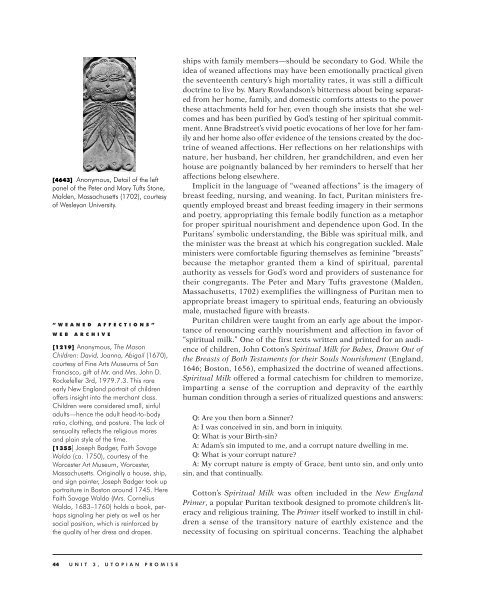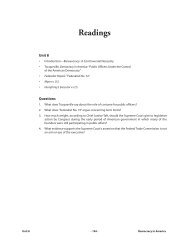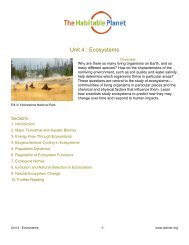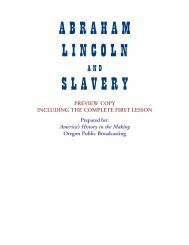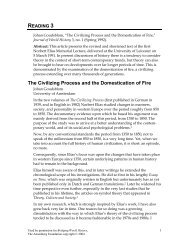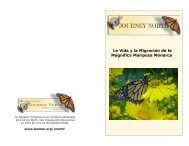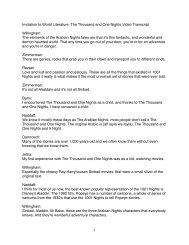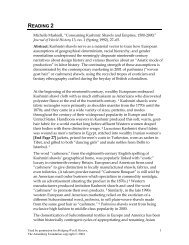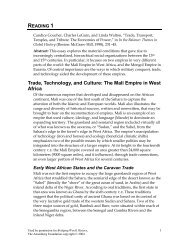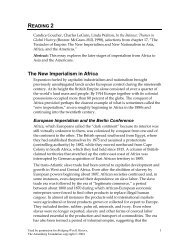UTOPIAN PROMISE - Annenberg Media
UTOPIAN PROMISE - Annenberg Media
UTOPIAN PROMISE - Annenberg Media
You also want an ePaper? Increase the reach of your titles
YUMPU automatically turns print PDFs into web optimized ePapers that Google loves.
[4643] Anonymous, Detail of the left<br />
panel of the Peter and Mary Tufts Stone,<br />
Malden, Massachusetts (1702), courtesy<br />
of Wesleyan University.<br />
“WEANED AFFECTIONS”<br />
WEB ARCHIVE<br />
[1219] Anonymous, The Mason<br />
Children: David, Joanna, Abigail (1670),<br />
courtesy of Fine Arts Museums of San<br />
Francisco, gift of Mr. and Mrs. John D.<br />
Rockefeller 3rd, 1979.7.3. This rare<br />
early New England portrait of children<br />
offers insight into the merchant class.<br />
Children were considered small, sinful<br />
adults—hence the adult head-to-body<br />
ratio, clothing, and posture. The lack of<br />
sensuality reflects the religious mores<br />
and plain style of the time.<br />
[1355] Joseph Badger, Faith Savage<br />
Waldo (ca. 1750), courtesy of the<br />
Worcester Art Museum, Worcester,<br />
Massachusetts. Originally a house, ship,<br />
and sign painter, Joseph Badger took up<br />
portraiture in Boston around 1745. Here<br />
Faith Savage Waldo (Mrs. Cornelius<br />
Waldo, 1683–1760) holds a book, perhaps<br />
signaling her piety as well as her<br />
social position, which is reinforced by<br />
the quality of her dress and drapes.<br />
44 UNIT 3, <strong>UTOPIAN</strong> <strong>PROMISE</strong><br />
ships with family members—should be secondary to God. While the<br />
idea of weaned affections may have been emotionally practical given<br />
the seventeenth century’s high mortality rates, it was still a difficult<br />
doctrine to live by. Mary Rowlandson’s bitterness about being separated<br />
from her home, family, and domestic comforts attests to the power<br />
these attachments held for her, even though she insists that she welcomes<br />
and has been purified by God’s testing of her spiritual commitment.<br />
Anne Bradstreet’s vivid poetic evocations of her love for her family<br />
and her home also offer evidence of the tensions created by the doctrine<br />
of weaned affections. Her reflections on her relationships with<br />
nature, her husband, her children, her grandchildren, and even her<br />
house are poignantly balanced by her reminders to herself that her<br />
affections belong elsewhere.<br />
Implicit in the language of “weaned affections” is the imagery of<br />
breast feeding, nursing, and weaning. In fact, Puritan ministers frequently<br />
employed breast and breast feeding imagery in their sermons<br />
and poetry, appropriating this female bodily function as a metaphor<br />
for proper spiritual nourishment and dependence upon God. In the<br />
Puritans’ symbolic understanding, the Bible was spiritual milk, and<br />
the minister was the breast at which his congregation suckled. Male<br />
ministers were comfortable figuring themselves as feminine “breasts”<br />
because the metaphor granted them a kind of spiritual, parental<br />
authority as vessels for God’s word and providers of sustenance for<br />
their congregants. The Peter and Mary Tufts gravestone (Malden,<br />
Massachusetts, 1702) exemplifies the willingness of Puritan men to<br />
appropriate breast imagery to spiritual ends, featuring an obviously<br />
male, mustached figure with breasts.<br />
Puritan children were taught from an early age about the importance<br />
of renouncing earthly nourishment and affection in favor of<br />
“spiritual milk.” One of the first texts written and printed for an audience<br />
of children, John Cotton’s Spiritual Milk for Babes, Drawn Out of<br />
the Breasts of Both Testaments for their Souls Nourishment (England,<br />
1646; Boston, 1656), emphasized the doctrine of weaned affections.<br />
Spiritual Milk offered a formal catechism for children to memorize,<br />
imparting a sense of the corruption and depravity of the earthly<br />
human condition through a series of ritualized questions and answers:<br />
Q: Are you then born a Sinner?<br />
A: I was conceived in sin, and born in iniquity.<br />
Q: What is your Birth-sin?<br />
A: Adam’s sin imputed to me, and a corrupt nature dwelling in me.<br />
Q: What is your corrupt nature?<br />
A: My corrupt nature is empty of Grace, bent unto sin, and only unto<br />
sin, and that continually.<br />
Cotton’s Spiritual Milk was often included in the New England<br />
Primer, a popular Puritan textbook designed to promote children’s literacy<br />
and religious training. The Primer itself worked to instill in children<br />
a sense of the transitory nature of earthly existence and the<br />
necessity of focusing on spiritual concerns. Teaching the alphabet


